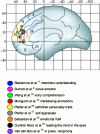Development of the social brain in adolescence
- PMID: 22434810
- PMCID: PMC3308644
- DOI: 10.1258/jrsm.2011.110221
Development of the social brain in adolescence
Abstract
The brain has evolved to understand and interact with other people. We are increasingly learning more about the neurophysiological basis of social cognition and what is known as the social brain, that is the network of brain regions involved in understanding others. This paper focuses on how the social brain develops during adolescence. Adolescence is a time characterized by change - hormonally, physically, psychologically and socially. Yet until recently this period of life was neglected by cognitive neuroscience. In the past decade, research has shown that the brain develops both structurally and functionally during adolescence. Large-scale structural MRI studies have demonstrated development during adolescence in white matter and grey matter volumes in regions within the social brain. Activity in some of these regions, as measured using fMRI, also shows changes between adolescence and adulthood during social cognition tasks. I will also present evidence that theory of mind usage is still developing late in adolescence. Finally, I will speculate on potential implications of this research for society.
Figures


References
-
- Barresi J, Moore C Intentional relations and social understanding. Behavioral and Brain Sciences 1996;19:107–54
-
- Amodio DM, Frith CD Meeting of minds: the medial frontal cortex and social cognition. Nature Reviews Neuroscience 2006;7:268–77 - PubMed
-
- Samson D, Apperly IA, Chiavarino C, Humphreys GW Left temporoparietal junction is necessary for representing someone else's belief. Nature Neuroscience 2004;7:499–500 - PubMed
Publication types
MeSH terms
LinkOut - more resources
Full Text Sources
Medical
Miscellaneous

